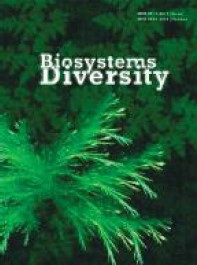Endoparasites of rabbits (Oryctolagus cuniculus domesticus) in Southern Ukraine
Endoparasites of rabbits (Oryctolagus cuniculus domesticus) in Southern Ukraine
Author(s): M. Bogach, A. P. Paliy, O. O. Horobei, L. V. Perotska, V. Y. Kushnir, D. M. BohachSubject(s): Regional Geography, Environmental Geography, Environmental interactions
Published by: Дніпропетровський національний університет імені Олеся Гончара
Keywords: Trichostrongylus retortaeformis; Nematodirus leporis; Passalurus ambiguus; Taenia pisiformis; Eimeria spp;
Summary/Abstract: One of the main tasks of ecological parasitology at the present stage is to establish patterns of spread of invasive diseases of animals in the environment through a thorough epidemiological examination, as well as to determine the main directions and factors of spread of parasites in Ukraine. Among the many pathogens, endoparasites play a major role in a number of diseases in rabbits with increased morbidity and mortality. In the body of both wild and domestic rabbits several species of parasites that form a parasitocenosis can be localized. The latter have a pathogenic effect on organs and tissues, leading to reduced weight gain, premature slaughter and even mortality. The prevalence of endoparasitoses was studied in weaned rabbits 60 days of age, 120 days of age at fattening, 180 days of age – mating age and adults of 320 days of age to determine the extensiveness and intensity of the dominant invasion. A total of 720 head was studied, 180 animals from each age group. Three species of nematodes were recorded in the rabbits: Trichostrongylus retortaeformis (Zeder, 1800), Nematodirus leporis (Ransom, 1907) and Passalurus ambiguus (Rudolphi, 1819); the cestode Taenia pisiformis (Bloch, 1780); three species of Emeria: Eimeria stiedae (Lindermann, 1865), which parasitizes in the bile ducts of the liver and gallbladder, E. magna (Perard, 1925) and E. media (Kessel, 1929) – in the epithelial cells of the intestine. The prevalence of the infestation depends on the age of the animals. According to the data obtained, eimeriosis was one of the main parasitic diseases of the rabbits. Dominant invasions of Eimeria in the intestines of 60-day-old rabbits were found in the studied animals, their extensiveness reached 19.4%, while the spread of hepatic Eimeria was registered in 13.3% of the examined rabbits. The total infestation of weaned rabbits with helminths was 22.2%, in rabbits for fattening – 26.7%, and in rabbits of mating age and adults – 20.0% and 20.6%, respectively. Global climate change will change the distribution and dynamics of soil-borne helminthiases, but host immunity may also affect host-parasite interactions. Subsequent studies will be aimed at elucidating the effect of mono and mixed invasions on the body of rabbits. Updated data on helminthiasis will expand the screening strategy to maintain rabbit health and reduce economic losses.
Journal: Biosystems Diversity
- Issue Year: 30/2022
- Issue No: 2
- Page Range: 173-178
- Page Count: 6
- Language: English

